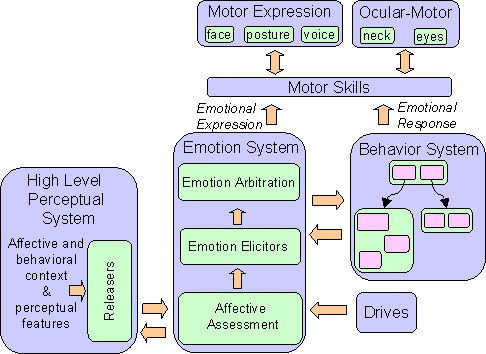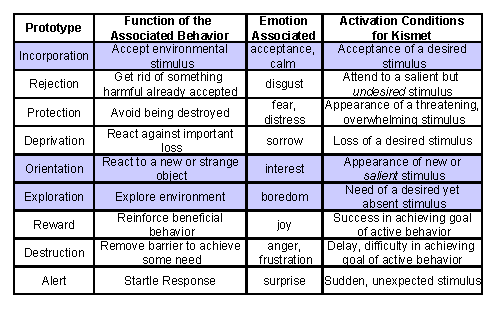

|
Emotions in Living Systems
Emotions play an important role in motivation for complex organisms (as well as being involved in memory retrieval, learning, attention, and reasoning). They seem to be centrally involved in determining the behavioral reaction to environmental (often social) and internal events of major significance for the needs and goals of a creature (Plutchik), (Izard). For instance, a number of emotion theorists suggest that positive emotions are elicited by events that satisfy some motive, enhance one's power of survival, or demonstrate the successful exercise of one's capabilities. They often signal that activity toward the goal can terminate, or that resources can be freed for other exploits. In contrast, many negative emotions result from painful sensations or threatening situations. Negative emotions motivate actions to set things right or prevent unpleasant things from actually occurring. Several theorists argue that a few select emotions are basic or primary -- they are endowed by evolution because of their proven ability to facilitate adaptive responses to the vast array of demands and opportunities a creature faces in its daily life (Ekman), (Izard). The emotions of anger, disgust, fear, joy, sorrow and surprise are often supported as being basic from evolutionary, developmental, and cross-cultural studies. Each basic emotion is posited to serve a particular function (often biological or social), arising in particular contexts, to prepare and motivate a creature to respond in adaptive ways. They serve as important reinforcers for learning new behavior. Several theorists argue that emotion has evolved as a relevance detection and response preparation system. They posit an appraisal system that assesses the perceived antecedent conditions with respect to the organism's well being, its plans, and its goals. For instance, Scherer has studied this assessment process in humans and suggests that people affectively appraise events with respect to novelty, intrinsic pleasantness, goal/need significance, coping, and norm/self compatibility. Hence the level of cognition required for appraisals can vary widely. These appraisals (along with other factors such as pain, hormone levels, drives, etc.) evoke a particular emotion which recruits response tendencies within multiple systems. These include physiological changes (such as modulating arousal level via the autonomic nervous system), adjustments in subjective experience, elicitation of behavioral response (such as approach, attack, escape, etc.), and displaying expression. The orchestration of these systems represents a generalized solution for coping with the demands of the original antecedent conditions. Emotions establish a desired relation between the organism and the environment -- pulling it towards certain stimuli and events and pushing it away from others. Much of the relational activity can be social in nature, motivating proximity seeking, social avoidance, chasing off offenders, etc. The expressive characteristics of emotion in voice, face, gesture, and posture serve an important function in communicating emotional state to others. Darwin stressed the major significance of emotional expression as signals of behavioral intention and their role in social interaction. By allowing others to know how we feel, we can influence their behavior. For instance, the crying of an infant has a powerful mobilizing influence in calling forth nurturing behaviors of adults. More generally, the signaling of emotion communicates the creature's evaluative reaction to a stimulus event (or act) and thus narrows the possible range of behavioral intentions that are likely to be inferred by observers. This information can be used by the observers to better shape their own behavior in response.
Models of Emotions in KismetSimilarly for Kismet, the organization and operation of the emotion system is strongly inspired by various theories of basic emotions in humans. It is designed to be a flexible system that mediates between both environmental and internal stimulation to elicit an adaptive behavioral response that serves either social or self-maintenance functions. Kismet's "emotions" are triggered by various events which are evaluated as being of significance to the ``well being'' of the robot. Once triggered, each "emotion" serves a particular set of functions to establish a desired relation between the robot to its environment. They motivate the robot to come into contact with things that promote its ``well being'', and to avoid those that don't.

The schematic above presents an overview of the emotion system. We have intentionally omitted many details and refer the interested reader to chapter 8 of the thesis for a more extensive description. The antecedent conditions come through the high-level perceptual system where they are assessed with respect to the robot's ``well being" and active goals. The result is a set of behavior and emotional response specific releasers. The emotional response releasers are passed to an affective appraisal phase where each active releaser is tagged with arousal, valence, and stance markers. In general, behaviors and drives can also send influences to this affective appraisal phase. All active contributions are filtered through the emotion elicitors for each emotion process. Each elicitor computes the relevance of its corresponding emotion process. In the emotion arbitration phase, the emotion processes compete for activation in a winner-take-all scheme. The winner can evoke its corresponding behavioral response (such as ``flee" in the case of fear). It also evokes a corresponding facial expression, body posture, and vocal quality. These multi-modality expressive cues are arbitrated by the motor skill system.

The table above summarizes, under what conditions certain emotive responses arise, and what function they serve Kismet. This table is derived from the evolutionary, cross-species, and social functions hypothesized by Plutchik (1991), Darwin (1872), and Izard (1977). The table includes the six primary emotions proposed by Ekman (1992) along with three arousal states (``boredom'', ``interest'', and ``calm''). By adapting these ideas to Kismet, the robot's emotional responses mirror those of biological systems and consequently seem plausible to a human observer. This is very important for social interaction with people. Each of the entries in this table has a corresponding expressive display. For instance, the robot exhibits sadness upon the prolonged absence of a desired stimulus. This may occur if the robot has not been engaged with a toy for a long time. The sorrowful expression is intended to elicit attentive acts from the human caregiver. Another class of affective responses relates to behavioral performance. For instance, a successfully accomplished goal is reflected by a smile on the robot's face, whereas delayed progress is reflected by a stern expression. Exploratory responses include visual search for desired stimulus and/or maintaining visual engagement of a desired stimulus. Kismet currently has several protective responses, the strongest of which is to close its eyes and turn away from threatening or overwhelming stimuli. Many of these emotive responses serve a regulatory function. They bias the robot's behavior to bring it into contact with desired stimuli (orientation or exploration), or to avoid poor quality or dangerous stimuli (protection or rejection). In addition, the expression on the robot's face is a social signal to the human caregiver, who responds in a way to further promote the robot's ``well being''. Taken as a whole, these affective responses encourage the human to treat Kismet as a socially aware creature and to establish meaningful communication with it.
Video of Affective Responses
|
|||||||||||||||||||||||||||||||||||||||||||||||||||